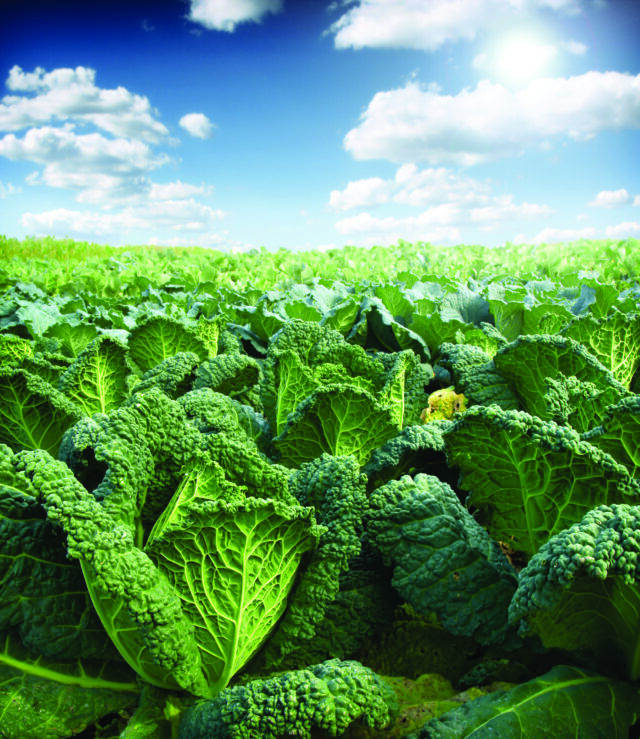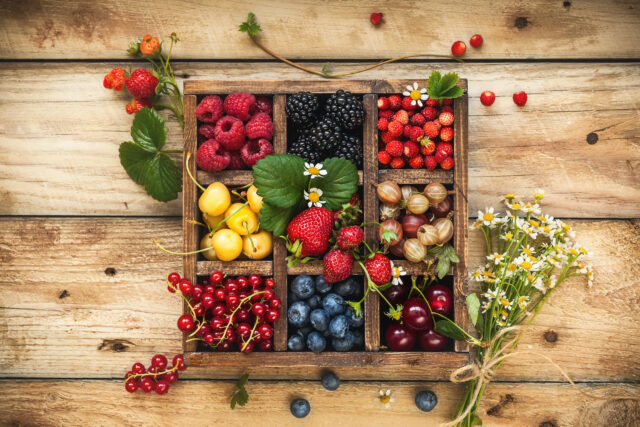
By Amely Greeven
Imagine opening your door on an ordinary summer morning and stepping into a Garden of Eden. Sunlight filters through a canopy of fruit trees laden with ripening peaches and plums, illuminating your skin with gold. A rainbow of colors—like purple-red figs, cherries and mulberries and deep-green vining spinach and moringa—enchants your eyes, the antithesis of a monochrome lawn. Your ears take in the gentle buzzing of bees feasting on pollen from fragrant almond blossoms, soon to bear nuts that you and your family can harvest, and flights of butterflies you haven’t witnessed in your garden for years. As your bare feet thrill to the coolness of moist ground underfoot, you relax into knowing that medicinal roots like turmeric and ginger and longevity-boosting mushrooms are growing here, tucked out of sight. A sensation of well-being expands through your body, and you smile before returning to the tasks and to-dos of the day.
This vision of abundance proliferating on the properties of ordinary folks and families—not accomplished farmers or dedicated homesteaders—is at the heart of a new global movement called Food Forest Abundance that launched just over one year ago. Tired of wrangling with the infinite problems of ecological collapse, toxic chemical infiltration in the environment and the radically unsustainable supply chains of our centralized food system (where food travels on average an estimated 1,500 miles from farm to fork, burning through a shockingly high amount of nonrenewable resources and delivering shockingly low nutrient levels), Food Forest Abundance’s founder Jim Gale pivoted to one big, all-encompassing solution: Empower regular people to turn parts of their properties (or unused land in their municipalities, schools, churches or declining Main Streets) into diverse “food forests”—regenerative edible landscapes in which plant species are stacked in artfully planned layers in order to feed people ultra-healthy, ultra-local, organic food; support a return to biodiversity and pollinator habitats; and resuscitate soil deadened from years of chemical application (or simply years of neglect). Food Forest Abundance aims to take the decades of wisdom behind permaculture design systems and regenerative food production—seen at larger scale in the movie The Biggest Little Farm as well as countless drool-worthy YouTube videos—and translate it into smaller-scale projects that anyone can do at home or in their town, regardless of their expertise. In so doing, it may just make the image of endless, perfectly manicured—and tragically underused—lawns feel as obsolete as 8mpg Hummers: a pesticide-saturated vestige of an outdated American Dream we’re ready to reimagine.
Here’s how it works: You, the homeowner (or community organizer), connect with Food Forest Abundance and buy a Food Forest Landscape Blueprint. Next, you collaborate with their designers, sending pictures and orientations of the land you have available—whether a small strip or plot, a sizable suburban yard or a more extensive estate. They assess its current health, light exposure, climate and more, discover your personal needs, wants and budget, and uncover its untapped productive potential. A blueprint is then created that places multiple species of perennial plants (fruit and nut trees, berry-producing shrubs, vining fruits and vegetables, and medicinal herbs and roots) in “layers” that support each other to thrive naturally, while annual vegetables like greens, tomatoes, beans, squashes and tubers get strategically mixed in to open spots for quicker harvest.

Open lawn space isn’t banished, necessarily; it just shares the spotlight with food- and medicine-producing zones that can be tidy and organized or wild and unkempt, depending on whether your taste skews rational or sensual. The range of possibilities of a personal or community food forest is infinite—some of the most established ones boast scores of edible and medicinal plants, and poultry or small livestock can most definitely be added in—though starting small by transforming an unused area by a swimming pool or guesthouse into a small permaculture garden is also more than OK. Blueprint in hand, you may potentially hire members of the group’s cooperative business model to install the food forest, or do it yourself—amending soil, landscaping areas to catch rainwater, and bringing in trees and shrubs at various stages of maturity (the more mature, the more expensive, but the sooner they produce bounty). The resulting gardens do not require endless maintenance, although, like any living system, they won’t tolerate disinterest or detachment—they ask you to dirty your hands a little. It can take four to five years for full perennial production to really kick in outside of subtropical zones—meantime, the annuals keep you fed—so a food forest is in some ways a legacy project—a way to steward your small corner of the world, and use resources wisely and regeneratively for good.
Taking the leap to start your own can involve pushing past limiting beliefs, like that you don’t know enough about plants, or are too time-pressed to give your land the attention required. Gale invites a mindset shift. “Mother Earth grows food for us for free when we let her; we just have to remember some things we forgot.” The shift in perspective is also about what wealth looks like. While there are upfront costs to make changes like these, creating a food forest is not an expense; it is an investment with long-term ROI. (Getting a small strip of yard going—designed and installed—could cost about $5,000; installing a dense food forest, half an acre or more, might run up to $50,000 to $90,000.) Sure, it will save significant money in food purchases over time. Gale says demure food forest gardens—a 10th of an acre in some cases—are producing volumes of food for a small family. Taking it further, a prolific food forester may choose to sell their bounty, or barter it, something that’s not nearly as hippie as it sounds, especially when friends start getting in on the game. (I’ve got fresh raspberries, you’ve got organic eggs; let’s make a deal.)
But the returns are also so much bigger than that—something I can personally attest to, four years into my own family reclaiming some very depleted land. The gifts from investing time, money and effort into one small corner of the world are hard to beat: greater connectedness to the present moment, as the only way to learn about your food forest is to shut up and watch it; and to the soul-soothing intelligence of nature in a world pushing the artificial kind down our throats (and your own natural intelligence, as realize you have the herb to treat your child’s ailment growing outside your kitchen window); and to food that tastes as good as nature intends it to taste (oh, those raspberries!); and to an inner confidence that if supermarket shelves fall bare, you have a small, self- reliant system producing food for your loved ones. It ripples out further, too: There’s greater connectedness within your family unit, as generations spend time outside being useful together, and even within your immediate community, as one permaculture pioneer on the block inspires the next one, or the elder neighbor you barely spoke to before becomes your mentor, guiding you in the journey.
Gale is a man with a big mission: to drive ordinary people into inspired action at a time where it can feel paralyzing to know where and how to start building a better world. “The most radically beneficial thing we can do for ourselves, our families and our communities at this moment is to turn some of our lawns into pieces of paradise,” he says. “Regenerative, edible landscapes are not only so much more beautiful to look upon, but can serve us on every single level that we can imagine—our physical and mental health, our ecology, our resources and the freedom that comes from growing our own food.”
foodforestabundance.com



